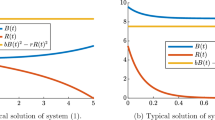Abstract
This paper discusses a stochastic duel model between two forces. On one side is the guerrilla (or terrorists) which has only one weapon (or person), and on the other an organized force of some sort which has many weapons. The model is called the many-versus-one guerrilla war. The guerrilla side has a number of advantages such as choice of location and time of engagement, concealment by topography, observation of the intended target, and line of fire. The authors present these advantages in what they believe are a realistic scenario of a duel between the guerrilla force and the organized force. By the four suppositions coinciding with the practical duel background, the paper presents the formulas to calculate the satisfying probability, the weak satisfying probability, and the acceptable probability of the attack side.
Similar content being viewed by others
References
Bracken J, Lanchester models of the Ardennes Campaign, Naval Research Logistics, 1995, 42: 559–577.
Hausken K and Moxnes K R, The microfoundations of the Lanchester War equations, Military Operations Research, 2000, 5: 79–99.
Williams T and Ancker C J, Stochastic duels, Operations Research, 1963, 11: 803–817.
Brown R H, Theory of Combat: The probability of winning, Operations Research, 1963, 11: 418–425.
Liu L, Yu J, and Guo Z, A kind of stochastic duel model for Guerrilla War, European Journal of Operational Research, 2006, 171: 430–438.
Liu L, Comments on ‘some discrete processes in the theory of stochastic duels’, Operations Research, 1996, 44: 416–417.
Jaiswal N K, Analysis of combat models, Annals of Operations Research, 1987, 9: 561–573.
Hausken K and Moxnes J F, Stochastic conditional and unconditional warfare, European Journal of Operational Research, 2002, 40: 61–87.
Gue K R, A dynamic distribution model for combat logistics, Computers & Operations Research, 2003, 30: 367–381.
Friedman Y, Optimal strategy for the one-against-many battle, Operations Research, 1977, 25: 884–888.
Kikuta K, A note on the one against many battle, Operations Research, 1983, 31: 952–956.
Author information
Authors and Affiliations
Corresponding author
Additional information
This research was supported by the National Science Foundation of China under Grant No. 60874118.
This paper was recommended for publication by Editor ZHANG Hanqin.
Rights and permissions
About this article
Cite this article
Liu, L., Li, J. & Qian, L. The probability analysis for the many-versus-one guerrilla war. J Syst Sci Complex 28, 645–660 (2015). https://doi.org/10.1007/s11424-015-2041-8
Received:
Revised:
Published:
Issue Date:
DOI: https://doi.org/10.1007/s11424-015-2041-8




